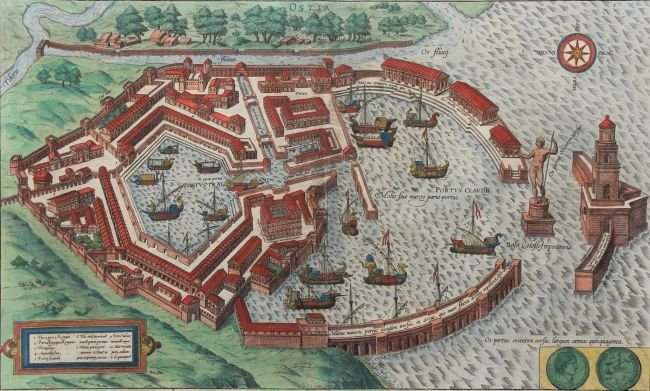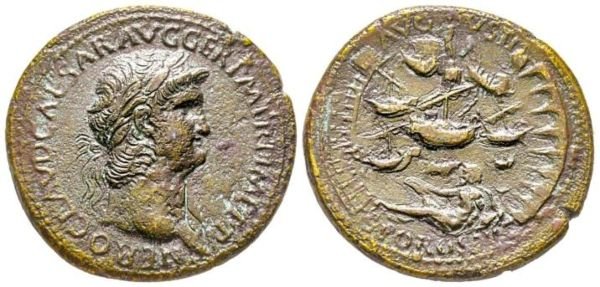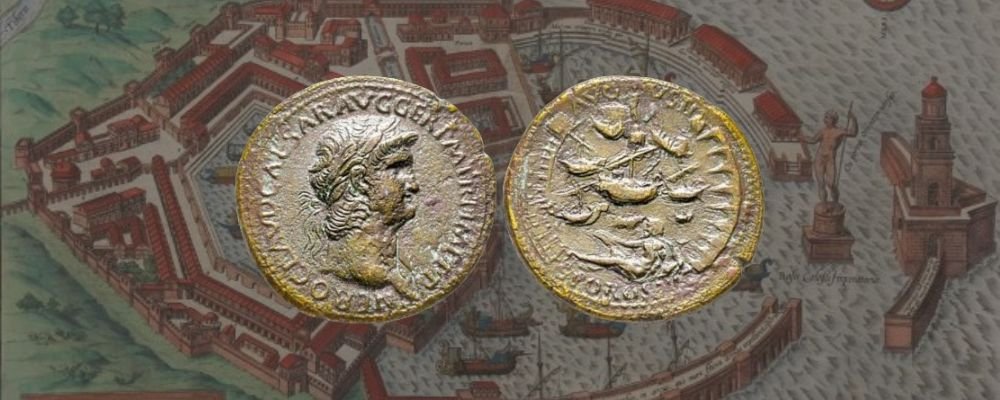Explore ancient Rome’s architectural marvels through Its coinage!
Embark with me, Victor Gordon, on a fascinating exploration of the Nero Port of Ostia Sestertius, a coin that commemorates one of the most significant engineering projects of the Roman Empire.
This coin not only illustrates the grandeur of Nero’s reign but also serves as a testament to his architectural ambitions. Discover the story, artistry, and lasting legacy of this remarkable coin.
Overview
The Nero Port of Ostia Sestertius is a bronze coin minted during the reign of Emperor Nero, specifically around AD 64. This coinage was part of a series intended to celebrate and publicize Nero’s reconstruction efforts and architectural innovations.
Among these was the expansion of the port at Ostia, Rome’s primary seaport, which was crucial for securing the grain supply essential for feeding the capital’s massive population.
History about Port of Ostia
Under Nero’s rule, Rome saw significant architectural development, including the grand projects such as the Domus Aurea and the expansion of Ostia’s port facilities.
Following a devastating fire in AD 64, which destroyed large parts of Rome, Nero took on extensive rebuilding efforts that included enhancing the infrastructure of Ostia. The port was expanded to include new warehouses and docks, improving Rome’s ability to handle imports, particularly grain from Egypt.

The Sestertius depicting the Port of Ostia was minted as a form of propaganda, aimed at bolstering Nero’s image as a benefactor and visionary leader amidst growing discontent with his rule.
Coin design
The design of the Nero Port of Ostia Sestertius is striking and informative:
- The obverse of the coin features the laureate head of Nero, signifying his authority and divine status as emperor.
- The reverse is particularly detailed, showing the port of Ostia with ships docked in the harbor and a pharos (lighthouse) in the background, symbolizing guidance and watchfulness. This depiction not only celebrates Nero’s architectural achievements but also serves as a visual assurance of Rome’s prosperity and stability under his leadership.

Current worth and collectibility
Today, the Nero Port of Ostia Sestertius is a prized item among collectors of Roman coins, valued for both its historical significance and its rarity.
The price can range from $5,000 to $75,000, although much depends on various currency factors.
These coins can command high prices at auction, particularly those in better condition with clear, detailed imagery. Collectors value this coin for its depiction of Roman engineering and governance, as well as for its connection to one of Rome’s most controversial emperors.
Curiosities and fun facts
- Nero’s reconstruction of Ostia included the addition of a large hexagonal basin, designed to accommodate more ships and protect them from storms, illustrating advanced Roman engineering.
- The Sestertius was a large coin, which allowed for detailed and elaborate designs, making it an ideal medium for imperial propaganda.
- Nero’s reputation and the later damnatio memoriae (condemnation of memory) decreed by the Senate after his death make any surviving representations from his reign particularly intriguing to historians and collectors.
Conclusion
The Nero Port of Ostia Sestertius is not just a piece of currency; it’s a fragment of history that offers insight into the political and architectural ambitions of Emperor Nero.
This coin allows us to appreciate the complexities of Nero’s reign through the lens of numismatics, offering a unique perspective on his contributions to Roman infrastructure and his methods of self-representation. For those passionate about ancient history and Roman coinage, the Nero Port of Ostia Sestertius stands as a testament to the enduring legacy of Rome’s architectural and imperial prowess.
Thank you for joining me in delving into the fascinating world of this historical coin. The Nero Port of Ostia Sestertius continues to captivate those who cherish the rich legacy of Roman engineering, governance, and numismatic art.
- Find images and more information about this coin on the official website of the British Museum.






